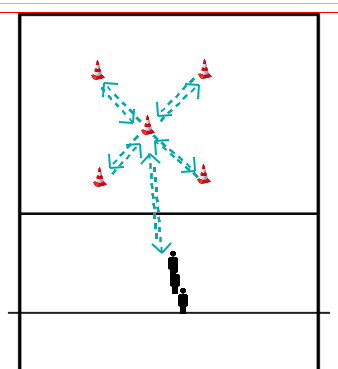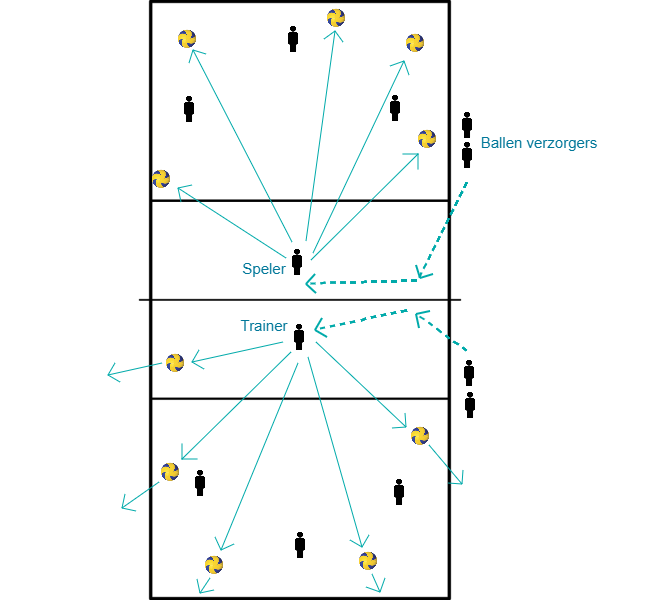Volleyball drills for
- Speed ladder is from the back line towards the net, in the middle of the field.
- Players move every round with a different movement pattern for the footwork through the speed ladder towards the net, then a block at position 3, move to position 2 or 4 (alternate) and a block again there.
- Then immediately step out to the defensive position on the 3-m line (with the cross move, immediately adopt a low stance and weight on the front feet).
- After the defensive position there are two options: either shuffle backwards towards the baseline or make a dive/roll towards the baseline. Optionally, an attack pass can be made towards the net first (with movement to the starting position for the attack pass).
- Depending on the team and their fitness level, increase the number of rounds the players have to make.
pair up.
- At the net with the ball
- other player on back line lying down.
- Stand up in different ways:
- just get up,
- through squatting,
- jump high in one go.
- Both players stand: at the net with the ball, ball is hit aimed. Pass back.
- Later: hit the ball harder (left/right/harder).
A varied warm-up where 6 benches standing next to each other with each +/-2-3m between them form the basis. See videos for exercises. It is a varied selection of exercises: running, running, jumping and strength exercises with and without a ball. Depending on the target group, you can choose the exercises.
1. 2 players start at the same time. One slaloms around the benches by starting on the right, the other by starting on the left.
- Forward in a run
- Give high-fives every time they cross each other.
- Every time they cross each other jump and hit each other's hands.
- Backwards
2. Same as 1, only it's not a slalom, but you meet in the middle every time.
- Lean on one knee and join hands. Then back again and walk around the bench.
3. 2 players remain simultaneously. Grab bench with two hands. Do legs over the bench three times. Then move to next bench and so on.
4. Same as 3, but they cross each other. Every bench one changes from left to right.
5. You jump as 3, once over the bench. Sit with your back against the bench. Grasp the bench with your arms. Legs stretched. Do 1 push up.
6. Same as 5, but you cross each other. Each bench is alternated between left and right.
Grasp the bench with your hands and your body stretched out. You make 1 push up. And jumps once over the bench.
8. Same as 7, but you cross each other. Each bank switches from left to right.
9. Combination of 6 and 8. Start at the first bench with a push forward, the next bench backward and so on until the last bench. In between they cross.
10. One jumps leg by leg over the benches in a running pace.
11. Same as 10, but they cross each other. Each bench is crossed from left to right.
12. One jumps on the bench. Then from 1 jump spread legs around the bench. You look at each other. Bench up-down-up and through.
13. Same as 12, but they cross each other. Every bench one changes from left to right.
14. Pairs. One player lifts up the bench at the right side. The other player crawls under the bench and grabs the next bench on the left. Now the other player goes under the bench, etc.
Foursomes. In fact the same as 14, only now the bench is grabbed by 2 players on both sides. Then 2 players go under it and hold up the next bench, etc.
- The trainer stands at the net.
- 1 person in the field.
- The trainer throws difficult balls
- the person in the field she has to play the balls back 3 times in a row underhand three times in a row.
- If he/she does not do this, you continue until he/she succeeds.
- The rest of the players stand around the field to catch the balls and put them back in the cart.
- Speed ladder is from the back line towards the net, in the middle of the field.
- Players move every round with a different movement pattern for the footwork through the speed ladder towards the net, then a block at position 3, move to position 2 or 4 (alternate) and a block again there.
- Then immediately step out to the defensive position on the 3-m line (with the cross move, immediately adopt a low stance and weight on the front feet).
- After the defensive position two options: either shuffle backwards towards the baseline or make a diving roll towards the baseline.
- Depending on the team and fitness level, increase the number of rounds the players have to make.
Divide the children into 2 groups; 1 counter and 1 person who does the exercise.
- 4 hoops lie in a square.
- The distance between the hoops is 5 metres.
- In each hoop there is a ball.
- The player starts in a corner with a ball in his hands.
- Swap as many balls in a row as possible, putting the ball in the hoop.
- The player has to look in the same direction.
- Each player has one turn.
- Count the number of ball changes in 45 seconds.
Instructions for the counters
- The balls have to be placed in the hoop.
- If the ball rolls out, the player must go back and put it back in!
- All four hoops must be completed in order.
- The player is not allowed to run back and forth between 2 hoops and swap balls!
- 2 teams (6,8,10 or 12 players)
- 1 person in the field (inside 3m line).
- Other players stand behind the 3m line in the waiting room.
- T puts ball in play in field A or B.
- You may only play the ball overhand within the 3m line.
- After playing the ball step out and someone in the waiting room takes your place.
- If you make a mistake, make sure you have the ball safe and encourage your teammates.
- If all the players of a team are eliminated, you have a point.
- Idem only underhand play
- idem overhand play only outside the 3m line
Make two equal groups;
Number 1 starts and walks to the centre pawn and from the centre to the other pawns as follows;
1. Right front back to the middle2
. Left front back to the middle3
. Right back to the centre4
. Back right to the center.
Then he taps the next one in line and he does the same.

- 3 attackers at the net, rest at the backline
- Attack, drop, attack => drop, attack, drop
- slalom between the posts and connecting again
- each 5 times
PURPOSE
Improve fitness and strength + warm up
ORGANIZATION
To crack a code by carrying out various tasks
IMPLEMENTATION
You can play this game with any 4 exercises you can think of.
1. Divide the group into two or three. These are the teams that will do the assignments.
2. The trainer makes a code of ten digits e.g. (24 32 14 21 33)
3. The players will do the exercises in a particular order. For example; they think the first digit is 3, so they will do exercises 3. When they have done them, they will go to the trainer and he will say whether the number is right or wrong. If the number is right, they try to guess the next number. If the number is wrong they have to do another exercise, for example exercise four, to guess the correct number.
Set 1;
Exercise 1: Push-ups 5 timesExercise
2: Sprint the distance between the back line and the middle line three timesExercise
3: Spiderman from the net to the back line and backExercise
4: Ten sit ups
Set 2
;Exercise 1: WheelbarrowExercise
2: TiggerExercise
3: Hand walkExercise
4: 15 count slice
The pair that cracks the code first wins.
- the coach is at the net.
- 1 person in the field.
- the trainer throws difficult balls
- The person in the field has to keep them off the ground (5 balls).
- if he/she does not do this, you continue until he/she has succeeded.
- The rest of the players stand around the field to catch the balls and put them back in the cart.
OBJECTIVE
Condition, speed, reaction ability and making appointments
ORGANIZATION
Two teams of three players form a team on either side of the pitch. Trainer + one player at the net pass the ball.

IMPLEMENTATION
- Trainer and a player roll balls into the field. These balls must not go over the outer lines of the field. If they do the team is out.
- The team that has finished is going to provide balls and a new team is going to enter the field.
- Start quietly and then slowly increase the pace.
- It is also important that agreements are made so that they are not all after the same ball!







